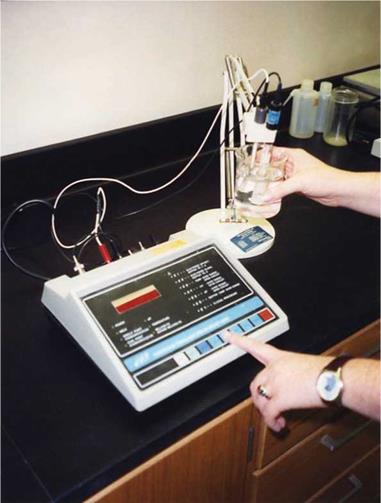The soil’s water, held between the particles and granules of the soil, contains dissolved mineral salts. This liquid is known as the soil solution. The way the soil solution reacts determines the acidity, alkalinity, or neutrality of the soil. Many farmers and home gardeners still refer to the “sweetness” or “sourness” of the soil, harking back to a time when differences in the soil’s reaction could be observed and dealt with even if the causes were not fully understood. Today it is understood that some soils contain more hydrogen ions (H+) than hydroxyl ions (OH-). This makes them acidic. Other soils contain more hydroxyl ions than hydrogen ions. They are termed alkaline. When a soil contains equal concentrations of hydrogen and hydroxyl ions, it is termed neutral. The exact relationship between the hydrogen and hydroxyl ions is expressed as a pH number (Figure 3-4).
• A pH of 7.0 is neutral.
• A pH of less than 7.0 is acidic.
• A pH of more than 7.0 is alkaline.
|
Optimum range for many crops Acidity range f————— A————– ^ Alkalinity range
3 4 5 6 7 8 9 pH values |
The pH of a soil can only be measured precisely using an instrument known as a pH meter (Figure 3-5). Commercial growers and homeowners can either send soil samples to state or private testing laboratories for a pH test at a nominal charge or purchase their own portable pH meter for immediate results. There are also pH test kits on the market, but their results are imprecise compared to those obtained with a pH meter. In situations in which the crop is very sensitive to soil pH, the pH meter test should be used.
Additions to the soil that increase the number of H+ ions will lower the pH of the soil; conversely, soil additions that increase the number of OH- ions will raise the soil pH. Many of the materials used to improve the structure and texture of the soil will also modify its pH. For example, peat moss is highly acidic, and its addition to the soil as a source of organic material will have a direct impact on the acidity of the soil solution. Limestone has the opposite effect, contributing alkalinity to the solution. These changes in the pH may or may not be desirable. Thus, additives should be used with caution and with a knowledge of their total impact. Obviously, it is easier to adjust the pH of a greenhouse
|
|
figure 3-5. A pH meter provides the most accurate measure of a soil’s acidity or alkalinity. (Delmar/Cengage Learning. Photo by Jack Ingels)
bench or pot crop in which the soil mixture is totally within the control of the grower than it is to change the pH of a 100-acre nursery field, especially since many soils have a strong buffer resistance to pH change. Buffering occurs when hydrogen ions that are held in adsorbed form dissociate from the clay particles and enter into the soil solution to replace those hydrogen ions neutralized by the addition of lime. No pH change will result until enough lime is added to deplete the supply of hydrogen ions that constitute a reserve of acidity in the soil. If the reserve acidity is strong and the field is large, a significant change in pH may be impossible. Where strong buffer resistance is not a factor, the pH of nursery fields can be altered to improve crop production.
Within the pH range of 4.0 to 9.0, the availability of many mineral nutrients is determined by the acidity or alkalinity of the soil. For example, many plants will exhibit a distinctively patterned yellowing, or chlorosis, when grown in soil having a high pH. The cause of the chlorosis is lack of iron in the plant tissue, and it results because iron compounds, needed by the plant, are precipitated out of the soil solution and rendered unavailable to the plant. At a lower pH, the iron will remain in the soil solution and be available for plant uptake.




